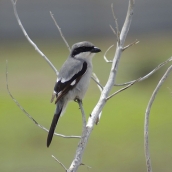Southern Grey Shrike (Lanius meridionalis koenigi)
This passerine measures 22-26 cm in length, has a wingspan of 28-32 cm and is often regarded as a miniature bird of prey, due to its eating habits. Dorsal plumage is greyish, underparts are paler, the head is covered by a black ‘mask’ and the wings have white wingbars; the tail is long and the bill is stout and hooked. In Macaronesia it only nests in the Canaries (Lanzarote, Fuerteventura, Gran Canaria and Tenerife, and the islets of Alegranza, La Graciosa and Lobos), where the subspecies L. m. koenigi is endemic to the archipelago. However, recent genetic studies show that it may be closely related to the North African great grey shrike and that both populations are really a separate species. In Cape Verde only one observation is attributed to the subspecies L. m. elegans, distributed throughout sub-Saharan Africa. This bird occupies low-lying xeric vegetation (lowland Euphorbia communities, stony plains, sand dunes and malpaíses or badlands), high montane scrubland (over 2,000 m) and open pine forests with shrubs, almond and fig trees. It is also seen on crops, in urban gardens and golf courses. To ensure development and density, each pair requires a certain amount of shrub cover in their territory. This species mainly feed on lizards (Gallotia spp.), insects, geckos (Tarentola spp.), skinks (Chalcides spp.), mice, shrews, snails and small birds, which it manages to catch by imitating their birdsong and call. It usually secures its prey on spiny shrubs and firm branches, resulting in the occasional stockpile. The breeding season begins in January and lasts until May, clutches of 4-5 eggs being the norm, although it can lay up to 6. Several nests are often dotted around a single area or even in the same shrub, which gives an idea of the territorial fidelity of this bird over the years. Relatively common in the Canaries (more abundant in Fuerteventura, Lanzarote and La Graciosa), it is not generally considered endangered. However, several negative factors affect this species, including habitat alteration and loss, roadkill and the use of poisons in agriculture.













